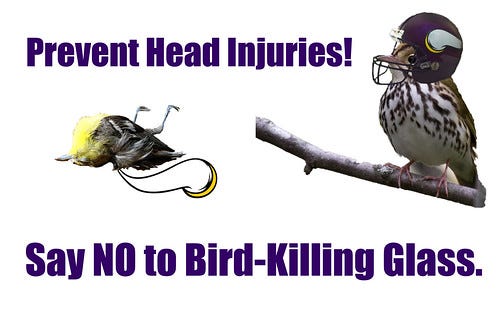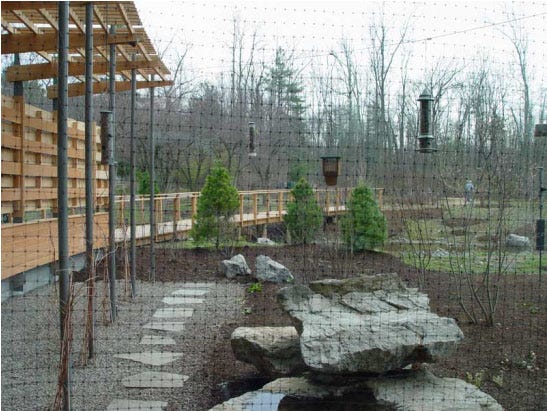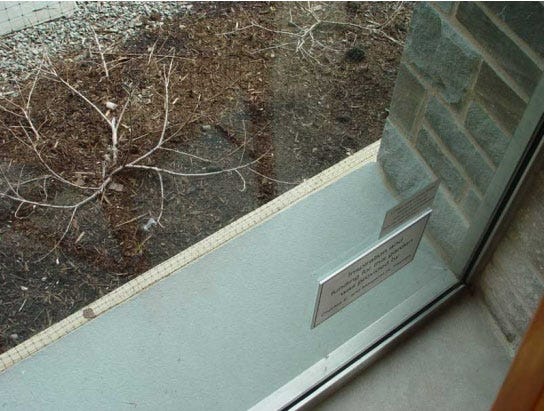(Listen to the radio version here and here. This post was too long for a single episode.)
In 2006—what seems like a century ago—I wrote a book, 101 Ways to Help Birds, in which I looked at a whole panoply of issues hurting birds and the kinds of individual actions we each should be taking to help. I covered a lot of ground, starting with how production of the food we eat, including coffee, beef, and sugar, affects birds for all kinds of reasons. I wrote about cat predation, window collisions, lawn and garden pesticides, conserving energy and water, the importance of native plants, our driving habits (in terms of both collisions with birds and conserving energy), the dangers of monofilament line and lead shot and bullets, how to ensure that our bird feeders are healthy and safe for birds, and much more. I encouraged readers to support agencies and non-profits that help birds and to take a more active role in political issues that directly affect the natural world.

Some of the issues I covered affect many more birds than others, and some affect the air, water, and soil that we all depend on more than others, but I wrote the book in part to make us more mindful about how every element of our daily lives has a direct impact on the birds we love as well as the environment.
I wrote the book in part to make us more mindful about how every element of our daily lives has a direct impact on the birds we love as well as the environment.
I unrealistically expected that the book would do well. I’d spent two and a half years thoroughly researching avian conservation and touching on important issues many people were not yet connecting to birds such as beef production, the decline of so many insects, and how critical native plants are, and I talked to a lot of authorities to get realistic assessments of each issue.
As it turned out, some of those very authorities disliked the book because they thought by covering so many of the issues affecting birds, I was giving short shrift to the one or two that they were focused on and believed were most important. Several were disturbed by my covering one issue in particular: window collisions.
In 2006, not one of the major bird conservation organizations considered window collisions a serious issue, though Dr. Daniel Klem of Muhlenberg College had been publishing studies about it since his 1979 Ph.D. dissertation. The Wilson Bulletin and Journal of Field Ornithology had both published his scientific work, but reviewers for the American Ornithologists’ Union’s journal The Auk rejected every one of his papers out of hand because they—some of the top ornithologists on the continent—didn’t think window strikes constituted a legitimate conservation issue. They wanted research to focus on habitat loss at nesting, wintering, and stopover areas rather than what they considered a minor, localized issue that didn’t affect many species.
In 1990, Klem published two papers in The Journal of Field Ornithology, “Bird injuries, cause of death, and recuperation from collisions with windows” and “Collisions between birds and windows: mortality and prevention” in which he calculated that between 100 million and 1 billion birds are killed in window collisions every year in the United States alone. Again, his work was dismissed by most conservation biologists. If they acknowledged Klem’s work at all, scientists at major conservation non-profits and universities said his numbers were off by orders of magnitude.
Klem had been approaching manufacturers to try to find a window glass that birds could see as an obstruction to avoid, but it was slow-going. If the major ornithological institutions were all denying that a problem even existed, how could glass manufacturers benefit from solving it? Klem did work with a manufacturer to develop “fritted window glass” (glass with the inner surface of the outer pane etched in a pattern to make the window at least a bit more visible to birds), which was used in the Dallas Cowboys’ stadium and some other buildings, but a prominent Minnesota ornithologist named Robert Zink claimed that it was not at all important for the Minnesota Vikings Stadium.
I met Daniel Klem in 2004 at the grand opening of the Cornell Lab of Ornithology’s Imogene Powers Johnson Center for Birds and Biodiversity. We were both dismayed at the huge bird-killing windows throughout the building. In the visitor center, the gigantic window overlooking the bird-feeding garden had already killed so many birds that bird netting had been placed on it.
I started working at the Lab in 2008 and discovered that the smaller windows in the offices and meeting rooms were just as bad, only more out of sight of visitors. I was utterly dismayed whenever I’d be in a meeting and heard that horrible “thump.”

Ironically, those bird-killing windows were also problems for people inside the building. On sunny days, the offices and meeting rooms were too hot and bright unless the shades were drawn, so we often couldn’t see the bird that hit. (I wrote to Martha Stewart, who is a birdwatcher, asking if she could design a stylish but sturdy exterior shade in tracks, or something similar, that could hide the glass entirely from the outside except when people were actually enjoying the view, but never heard back. I also wrote to the producers of This Old House asking if they could discuss bird collisions on the show with some strategies to minimize them, but never heard from them, either.)
Scientists continued to minimize the issue, saying that windows do kill “individual birds,” but those deaths weren’t significant “at the population level.” What we needed to work on was habitat. But something was finally about to change.
In 2009, Daniel Klem presented a paper at a conference of the International Partners in Flight titled, “Avian Mortality at Windows: The Second Largest Human Source of Bird Mortality on Earth.” The news media picked up on it, and suddenly conservation biologists were being inundated with questions about window collisions. Because they had long been saying the problem was trivial compared to habitat loss, they launched their own studies to finally prove their case and put the issue to rest.
Except oops!—their own studies proved that Klem was spot on. But rather than admit they’d been wrong to dismiss his work for over a quarter century, they made it sound as if their scientists had just discovered a brand new problem.
In 2017, I got an email invitation to attend an online seminar, sponsored by two of the most prestigious bird conservation organizations, about window collisions and ways we can minimize them. The description said the presenter had “discovered” after a thorough literature search that there was “virtually no science or basis for most recommendations.” As a stay-at-home mom in the 1980s lugging a baby or toddler to the University of Minnesota-Duluth library, I’d unearthed more research than this scientist did with all her access to modern databases, and with all the additional research on both collisions and how to prevent them that Daniel Klem and now others had produced since the 80s! I was mystified.
The way our country allocates so very few resources for conservation work, researchers, institutions, and organizations must scrabble for every donation and grant, leading to cutthroat competition. As more researchers started working with glass manufacturers, they stayed in competitor rather than collaborator mode. At this point, no glass is 100 percent bird safe, but to find the best realistic solutions, scientists must remember that the whole point of this critical work is to protect birds, not to shore up their own standing and funding by ignoring or even attacking others trying to solve the same problems.
Meanwhile, in recent months I’ve been getting mass emails from the Ornithology Center at Muhlenberg College with subject lines such as “Experts Warn the Native Plants may Create Ecological Traps,” filled with dire warnings against growing native plants because windows are the real problem.
I’ve had breast cancer and two heart attacks—should I start sending out mass emails telling people to forget about colonoscopies? Whether it’s keeping our bodies or our birds safe and healthy, multiple approaches are essential. Since my very first radio programs in 1986, I’ve encouraged growing native plants and best practices for bird feeders even as I’ve also focused on making our windows as bird-safe as possible.
I’m dismayed that the very scientist who was the victim of other scientists minimizing the value of his research on window collisions for so many decades is part of a new effort to minimize the importance of backyard habitat. It’s not either/or! Safe glass and natural habitat are BOTH essential for the future of birds.
Whether we have expertise in a single conservation issue or a hundred; whether our primary focus is native plants, window collisions, pesticides, cat predation, climate change, Bird Friendly certified coffee, beef production, mowing schedules to protect nestling Bobolinks and meadowlarks, or anything else; and whether we’re individuals on our own or part of larger institutions or organizations, let’s all of us who care about birds aim our fire at what’s hurting them, not at one another.








